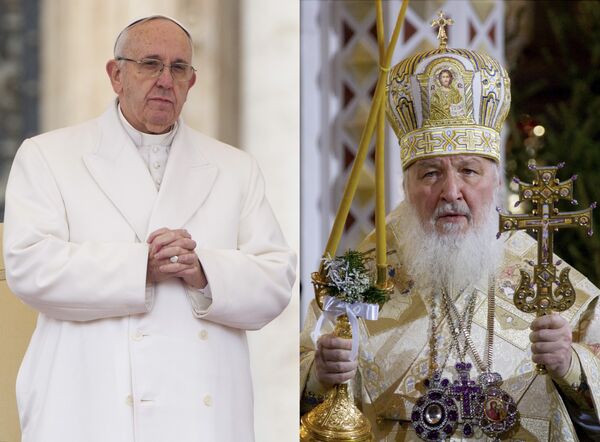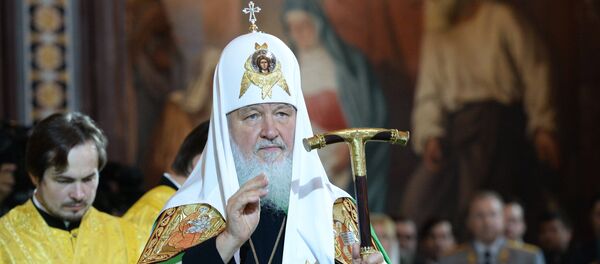MOSCOW (Sputnik) — Pope Francis and Patriarch Kirill of Moscow and All Russia are meeting in Cuba on Friday.
Following is a factbox on relations between the Russian Orthodox and Roman Catholic churches.

Catholicism is the largest Christian denomination. The Roman Catholic Church is strictly centralized and organized in a hierarchy, although there are several dozen local Catholic churches all over the world. The Church is led by the Pope, who has his residence in Vatican City.
There was a papal nunciature (diplomatic mission) in Russia from the late 18th century through 1917. The Archbishop of Mogilev, with residence in St. Petersburg, was the Metropolitan of the Roman Catholic Church. The Russo-Vatican concordat of 1847 recognized the Pope as the head of Russian Catholics. Russia terminated the concordat unilaterally in 1866. Since then, Russian and Polish Catholics could contact the Curia solely through the Interior Minister. The Emperor appointed Catholic bishops on agreement with the Pope.
Following the October 1917 Revolution, the Catholic clergy fell under the Soviet government decree of January 23 (February 5, New Style) on the separation of the Church from the state and the school from the Church.
There were two Roman Catholic dioceses in the USSR: the Lithuanian, whose bishop’s jurisdiction was limited to Lithuania, and the Latvian, whose archepiscopal jurisdiction crossed Latvia’s borders to spread to the entire Catholic diaspora in the USSR with the exception of Belarus, where an independent Minsk diocese was established in 1989.
The relations between the Russian Orthodox and Roman Catholic churches rose to a new level after the second Vatican Council (1962-1965), with its spectacular change of the Catholic social doctrine and ecumenical principles. The Roman Catholic Church officially recognized the Russian Orthodox Church, which responded by opening official dialogue with it in 1980. The Joint International Commission for Theological Dialogue was established then.
Tensions between the Vatican and Moscow Patriarchate rose in the early 1990s with the rise of Catholic proselytism in Russia and other CIS countries, and clashes between the Orthodox and Greco-Catholic communities in western Ukraine.
The Moscow Patriarchate defines Catholic proselytism as "clerical activities to involve Russians devoid of historical connection with Catholicism and belonging to Orthodoxy by baptism and cultural tradition, into liturgical and other Catholic practices."
Tensions between the Orthodox and Greco-Catholic communities in Ukraine led to another problem as the latter transferred its center from Lviv to Kiev, and sought promotion to the status of Patriarchate. It established missions in Ukraine’s traditionally Orthodox east and south, and supported Old Believers to exacerbate the problem. There were violent outrages, as at the turn of the 1990s when Greco-Catholic activists ransacked three dioceses of the Moscow Patriarchate in western Ukraine.To settle these dramatic matters, the Joint Working Group on interaction problems between the Russian Orthodox Church and Catholic Church in Russia was established in 2004.
The conflict worsened in 2002, when John Paul II promoted the Roman Catholic entities in Russia to dioceses. Russia’s Church, secular authorities and public-at-large regarded it as a hostile move. Patriarch Alexy II, the Holy Synod, Foreign Ministry, State Duma, several major NGOs, and political and religious activists made angry statements approved by representatives of other religions long established in Russia.
The Greco-Catholic union remains an obstacle to normal inter-Church relations to this day. The situation became worse with the recent developments in Ukraine, in which Greco-Catholics were extremely active under anti-Russian slogans.

The dialogue is mediated by the Nunciature. There are also direct high-level contacts between Cardinal Kurt Koch, the president of the Pontifical Council for Promoting Christian Unity, and Metropolitan Hilarion of Volokolamsk, head of the Moscow Patriarchate Department for External Church Relations, and annual meetings on cultural exchanges and student programs. Metropolitan Hilarion takes part in crucial Catholic Church events. Orthodox hierarchs are involved in the developing cooperation with the Pontifical Council for Culture.
A working group (commission) for cultural cooperation began to work in February 2015. It was established on the basis of understandings between the Moscow Patriarchate Department for External Church Relations, led by Metropolitan Hilarion, and the Pontifical Council for Promoting Christian Unity, headed by Cardinal Kurt Koch. Commission activities resulted in the "Light of Christ Enlightens All" Orthodox-Catholic project, implemented for the Catholic Church’s Extraordinary Jubilee Year of Mercy, which commenced in December 2015.




